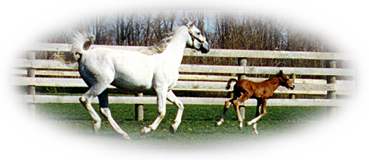This story appeared in the Lancaster Sunday News, written by Pat Johnson
The day Ron Hevener called to announce the birth of Naja, he was as excited as any new father. To Hevener, Naja’s birth was evidence of just one more miracle in the unfolding events of Nahgua – a horse that Hevener says he saved “in the nick of time.”
Hevener has told his story often. He loves to tell it and has had it published in many horse magazines.
“All I did was follow a hunch,” Hevener, says. On an impulse, he attended the Monday horse sale at the New Holland Sales Stables several years ago. “I grew up with horses, but had been living in the city and had no time for a horse. I can’t tell you why, but I remembered the horse sale and just decided to go to it.”
He describes the sale as “A place where hundreds of horse traders gather on Mondays in a bizarre mixture of cowboy hats, English riding boots and Amish suspenders, buying and selling horses and horse paraphernalia of all kinds.”
He looked over the horse, from his long, elegant, arched neck to his flaring nostrils, from his shoulders to his tail. Then he saw it – a red slash of crayon through a sales tag on the stallion’s rump. “My heart sank,” he says. “He’d already been sold.” But Hevener, not one to give up on love so easily, looked for someone to question about this horse.
In the dusty sales arena, Hevener found only one man, but he was the right man. “He knew which horse I meant and took me into the office, checked the day’s sales records and told me that the magnificent Bay had been sold to the horsekillers. “Do you want to save him?” the man asked Hevener.
Without stopping to think of cost, convenience or any practical matters, Hevener said yes. “It was one of those times when feelings overcome logic, and the heart makes up the mind.”
When told the price, Hevener discovered that “What it took to save this fascinating stallion was exactly the amount I had with me. It’s all just like it was meant to be,” he says with an engaging smile. “There was a connection between us. I feel that connection even more today.”
As Hevener finalized the transaction and turned back to his horse, he saw someone leading the stallion away and loading him into the slaughterhouse truck.
In less than a minute, Hevener and the sales barn representative had the stallion in another stall. “They let me keep him at the sales stable for about a week,” Hevener says. “They couldn’t have been more helpful. At that time I was living in a major city (Philadelphia) and had no place to keep a horse, no tack, nothing.” After a week, the stallion – now called Nahgua – was moved to a stall at the Quentin Riding Club in Lebanon County, Pennsylvania.
Hevener realized that this was not your ordinary horse. While still living in Philadelphia, he enlisted the efforts of Jim Benedict of the Arabian Horse Registry Special Investigations Division in Colorado.
It took two years of searching, but it was worth it, he says. “Unknowingly, I had found one of the few Arabians who are not only successful race winners, but halter champions (show horses) as well.”
Nahgua raced under the name “Nugui El Khamsin” and as a 3 year old was Michigan’s Arab Colt of the Year. As the owner of a prized racehorse, Hevener was suddenly part of Arabian racing. “It was time to start a new lifestyle away from the city.”
And, in a sense, he said, perhaps Nahgua was looking out for him. “The night I moved, I avoided a random shooting and double murder outside my apartment.
Nahgua is now registered as an Arabian Race Cup sire.
“The Arabian racing scene fills my life with expectation and healthy, competitive activity. At a time when many of my peers are melting away into dull and boring couch potatoes, I look forward to Nahgua’s sons and daughters building an American horseracing dynasty.”

